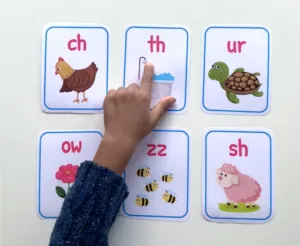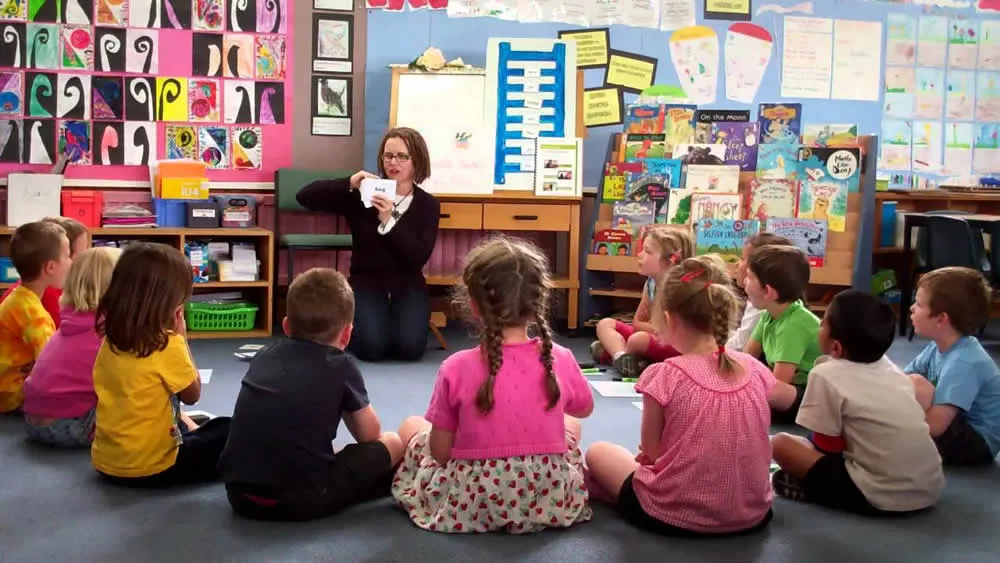Phonic Course

Source: ftcdn
Phonic Course
Uncover the transformative power of phonetics in education with the Phonic Course offered by Vidhyanidhi Education Society (VES). Imagine a classroom where every child has the tools to not only recognize and understand letters but also to associate them with sounds and blend them into words, unlocking the magical world of reading and writing.
This journey through the realm of phonetics fosters an environment where learning is not a task, but an exciting adventure filled with the joys of discovery and knowledge. Let’s explore this enlightening path together, enriching our teaching skills, and fostering a love for language in our students’ hearts.
Table of Content
- Benefits of Phonics
- Career Scope for Phonics Teacher
- Benefits of Pursuing Phonics Teacher Training From VES
- Duration of Phonic Course
- Eligibility for Phonic Course
- Curriculum for Phonic Course
- Phonics Course Fees
- Phonics Courses for Teachers in Mumbai
- Structure of Phonic Course
- How to Teach Phonics to Preschool
- How to Teach Phonics to First Graders?

Source: cdnparenting
Benefits of Phonics
Below are the Benefits of Phonics:
- By incorporating Phonics into their pedagogical techniques, teachers can help children decode the myriad phonetic sounds of letters, equipping them with the skills to read both independently and accurately from a young age.
- The children’s vocabulary expands and they develop a consistent reading routine.
- Unlike traditional learning methods, Phonics eradicates the need for memorizing spellings.
- The methodology instills a love for the English language, making learning a delightful experience.
- Phonics alleviates learning-related stress, offering a simplified pathway to mastering reading, writing, and spelling.
- Children following the Phonics method often excel in their academics, resulting in commendable school grades.
Career Scope for Phonics Teacher
With the credentials from our Phonic Course, you can expect the following Career Scope for Phonics Teacher:
- Lay the foundations of a dedicated teaching facility for child phonics, driving early language and literacy development.
- Assume roles in educational establishments adhering to State, CBSE, ICSE, IGCSE, or IB board syllabi across India or even on an international platform.
- Branch out into specialized teaching or remedial instruction, providing targeted support for students who need additional help in phonics.
- Step into the role of a phonics mentor at any educational institution, nurturing the skills of fellow educators.
- Participate in the planning and development of phonics curriculums or content, innovating the methods used to teach young learners about sound and letter relationships.
Benefits of Pursuing Phonics Teacher Training From VES
The several Benefits of Pursuing Phonics Teacher Training From VES are:
- VES employs the renowned Synthetic Phonics methodology from the UK as the framework for imparting effective phonics teaching skills.
- We foster a blend of skill acquisition, theoretical knowledge, and a supportive learning atmosphere to promote optimal professional growth.
- We advocate for a highly interactive teaching experience with numerous practice sessions, constructive revisions, collaborative learning, and insightful demonstrations.
- We arm the participants with an array of learning materials such as an exhaustive study pack, insightful handouts, multimedia teaching aids, and more.
- VES bestows in-depth insights and guidance to aid participants in starting and running their successful phonics classes.
- Led by a panel of industry experts and experienced trainers to provide superior guidance.
- Priced at a cost-effective rate, making quality phonics education accessible.
For additional information, dial or message us at +919869546913 / +919869866277.
By Clicking Here, you can download the brochure.

Source: parenting
Duration of Phonic Course
18 enriching hours Duration of Phonic Course, equips you with all the necessary skills and knowledge to instruct Phonics seamlessly.
Eligibility for Phonic Course
Eligibility for Phonic Course is open for those with a sound understanding of the English language.
Curriculum for Phonic Course
This advanced course provides educators with the tools and techniques to confidently teach phonics to their students.
The Curriculum for Phonic Course focuses on the following aspects:
Phoneme Awareness
Engage with interactive stories, activities, and jingles to understand individual letter sounds.
Letter Creation
Acquire techniques to teach the formation of each alphabet letter.
Fusion of Phonemes
Understand the process of blending to combine sounds for reading.
Sound Breakdown
Learn how to segment words into their sounds for effective spelling.
Consonant Cluster Exploration
Investigate the world of initial and final blends.
Digraph Discovery
Unravel digraph sounds through immersive stories and actions, and distinguish them from blends.
Dealing with Exceptional Words
Learn strategies to tackle tricky words that don’t adhere to standard phonics rules.
Phonics Law
Immerse in the fundamental rules that define phonics.
Variations in Vowels
Discover the different sounds and spellings associated with vowels.
Phonics Course Fees
Participating in our Phonic Course for Teachers is a valuable investment that won’t drain your budget. We’ve positioned our Phonics Course Fees to fit comfortably within your financial expectations.
Take advantage of our diverse range of promotional deals and substantial discounts, making this course an unmissable opportunity for educational enhancement.
Our array of simple payment options is designed to fit into your financial strategy, further facilitating your journey toward becoming an exceptional phonics instructor.
For additional information, dial or message us at +919869546913 / +919869866277.
By Clicking Here, you can download the brochure.

Source: wordunited
Phonics Courses for Teachers in Mumbai
Dedicated to offering a comprehensive learning experience, the VES institute near Borivali (west) station hosts Phonics Courses for Teachers in Mumbai. The class is scheduled flexibly, with both weekday and weekend workshops available. These workshops focus on interactive learning methods, allowing participants to learn through story-telling, engaging in role-play, singing pedagogical jingles, and working through educational worksheets.
The workshops also guide trainees in creating their teaching aids and offer expert advice on launching their phonics centers. Delivered by knowledgeable trainers, these workshops foster an atmosphere of active participation and extensive practice.
Structure of Phonic Course
Dive into an empowering journey of phonetics with Vidhyanidhi Education Society’s (VES) Phonic Course for Teachers.
Our Structure of Phonic Course is geared towards enhancing your career and enriching your life.
Customizable Class Timings
Be it a weekday batch running from Monday to Friday or a weekend batch scheduled for Saturday and Sunday, we offer options to match your preferred times, ensuring a stress-free learning environment.
Consistent Course Availability
Our batches roll out at regular intervals throughout the year, ensuring the door to knowledge remains open for you at all times, promoting continuous growth and development.
Transparent and Fair Evaluation
We conduct a straightforward on-the-spot evaluation test before bestowing our certification. Our fair process ensures that your efforts are properly acknowledged.
How to Teach Phonics to Preschool?
To prepare kids for kindergarten and beyond, phonics instruction is important during their preschool years. The link between letters and sounds in a language is called phonics. Learning phonics will help your child to understand and learn spelling patterns and, ultimately, learn to read.
Here are some strategies for How to Teach Phonics to Preschool:
Start with the Alphabet
Teach your child the names of the letters first before moving on to the sounds that they make. You can use alphabet songs, flashcards, or alphabet books to make this more enjoyable.
Letter Sounds
Once they are familiar with the letters themselves, introduce them to the sounds that each letter makes. Begin with consonant sounds as they are more consistent.
Phonemic Awareness
This is the proficiency to listen, recognize, and manipulate individual sounds, called phonemes in spoken words. You can help develop phonemic awareness through games that involve sounds. An example question you can ask is, “What is the beginning sound in the word ‘bat’?” or “What word do you have if you remove the ‘b’ sound from ‘bat’?”
Blending Sounds
Start teaching them how to blend sounds to form words. Start with simple two-letter words, such as “at,” “it,” “in,” etc. Then you can gradually move to three-letter words.
Rhyming Words
Teach your child rhyming words to help them understand how word patterns work. This can be done through songs, books, or nursery rhymes.
Phonics Games and Activities
Make learning phonics fun and engaging by using games and activities. This could be anything from phonics hopscotch, where your child jumps on letters to make words, to phonics apps that make learning interactive and fun.
Phonics Books
There are plenty of phonics books available that are suitable for preschoolers. These books emphasize certain sounds and can be a great tool to reinforce what your child has learned.
Regular Practice
Like any other skill, practice is key in learning phonics. Spend some time every day practicing phonics with your child. This will not take much time; a few minutes each day will have a noteworthy impact.
Patience
Remember that each child learns at their own pace. Be patient and attempt to come up with fresh strategies to help your child learn new sounds or words if they are having trouble with them.
Remember that it’s crucial to make the process entertaining and interesting. Your child is more likely to persist with it and eventually develop into a more certain and competent reader if they love studying phonics.

Source: ytimg
How to Teach Phonics to First Graders?
Teaching phonics to first graders is a vital task that can significantly impact their reading skills. Phonics instruction enables children to read and spell correctly without assistance by understanding and applying the Phonics principle of systematic and predictable affinities between written letters and spoken sounds.
Here are some steps and strategies that might help How to Teach Phonics to First Graders:
Start with the Basics
Begin by teaching the alphabet and the sound each letter makes. This can be done through a combination of activities such as songs, flashcards, and hands-on exercises.
Use Visual Aids
Use charts and pictures to visually demonstrate the relationship between sounds and letters. This aids kids in linking the sounds they hear and the letters they see.
Phonemic Awareness
The capacity to hear and control the sounds in spoken words as well as the knowledge that spoken words and syllables are composed of spoken sound sequences are required for this. You can play games that involve rhyming, beginning sounds, ending sounds, and middle sounds to increase your phonemic awareness.
Teach Phonics in Order
Generally, it’s best to start with the most common sound/spelling relationships, beginning with consonant-vowel-consonant (CVC) words (e.g., cat, bed, dog) and progressing to more complex patterns.
Sounding Out Words
Teach them to sound out words. If they struggle with a word, help them by saying each sound slowly and separately, and then help them blend those sounds to make the word.
Use Decodable Books
Decodable books contain only the phonetic code the child has already learned, which allows them to practice reading without encountering unlearned letter-sound correspondences.
Practice and Repetition
Phonics is a skill that takes time and repetition to learn. Make sure that children have lots of opportunities to practice each new sound and letter combination before moving on to the next.
Phonics Games
Make learning fun by turning phonics lessons into games. You may make your games like “Phonics Bingo,” “Sound Matching Game,” “Phonics Treasure Hunt,” etc. in addition to playing the numerous internet games that are already accessible.
Multisensory Techniques
To improve learning, employ multimodal strategies. This can include using sandpaper letters to feel the shape of the letter, jumping on a trampoline while saying the sounds, or writing in sand or shaving foam.
Consistent Feedback and Encouragement
Always provide feedback to the student on their progress and encourage them, even when they make mistakes. Their confidence might be boosted and their propensity to participate actively increased by this encouraging feedback.
Keep in mind that every child learns at their rate, so it’s crucial to be understanding and encouraging during this process. Instilling a love of reading in kids is essential since it will encourage them to improve their phonics abilities.
“Craft a promising future with Phonic Course, join Vidhyanidhi now!”
For additional information, dial or message us at +919869546913 / +919869866277.
By Clicking Here, you can download the brochure.
FAQ
How to Become a Certified Phonics Teacher?
Become a certified Phonics teacher with VES! Their innovative, exciting program ensures top-notch Phonics instruction skills.
What Is Synthetic Phonics?
Synthetic Phonics is an approach where letter sounds are taught first, then blended to form words. It's effective for reading.
What Is Systematic Synthetic Phonics in Early Years?
Systematic Synthetic Phonics in Early Years involves teaching children to read by linking sounds to letters systematically.
What Is Phonics Learning?
Phonics Learning is the method of teaching reading and writing by associating sounds with symbols in an alphabetic system.




